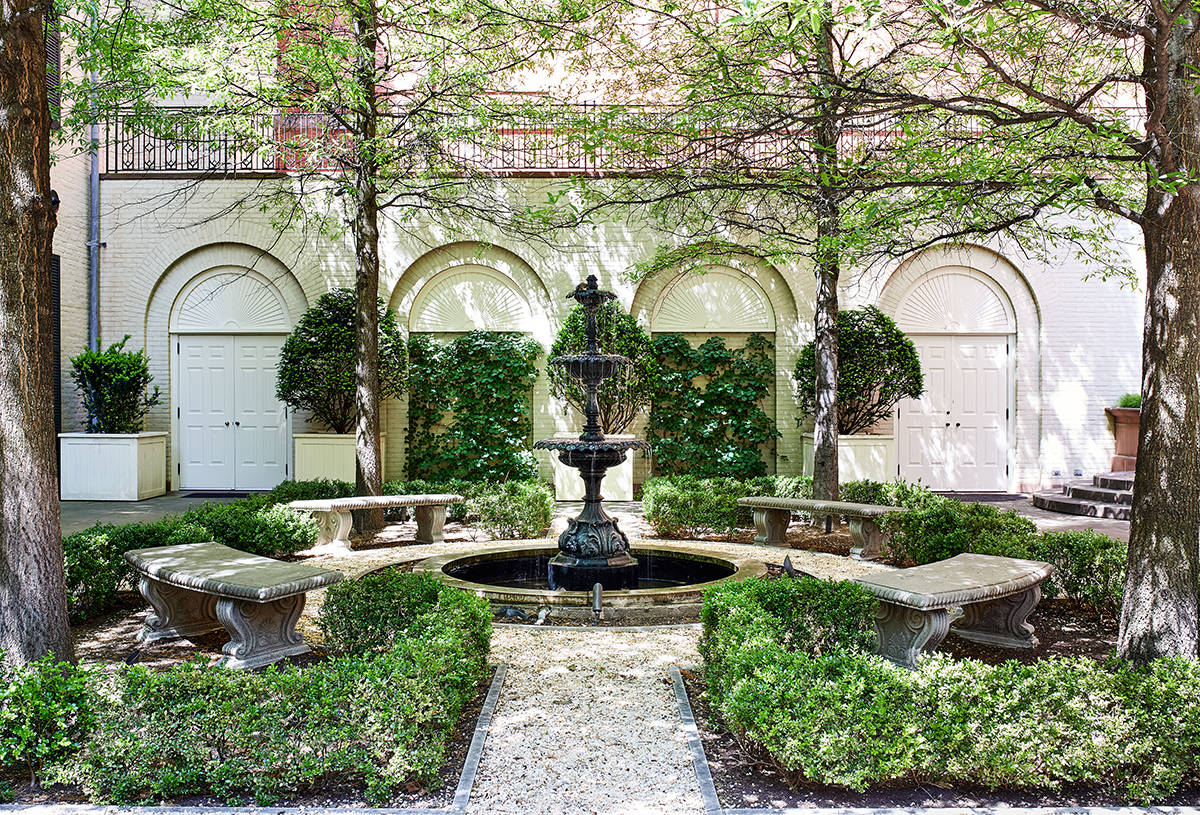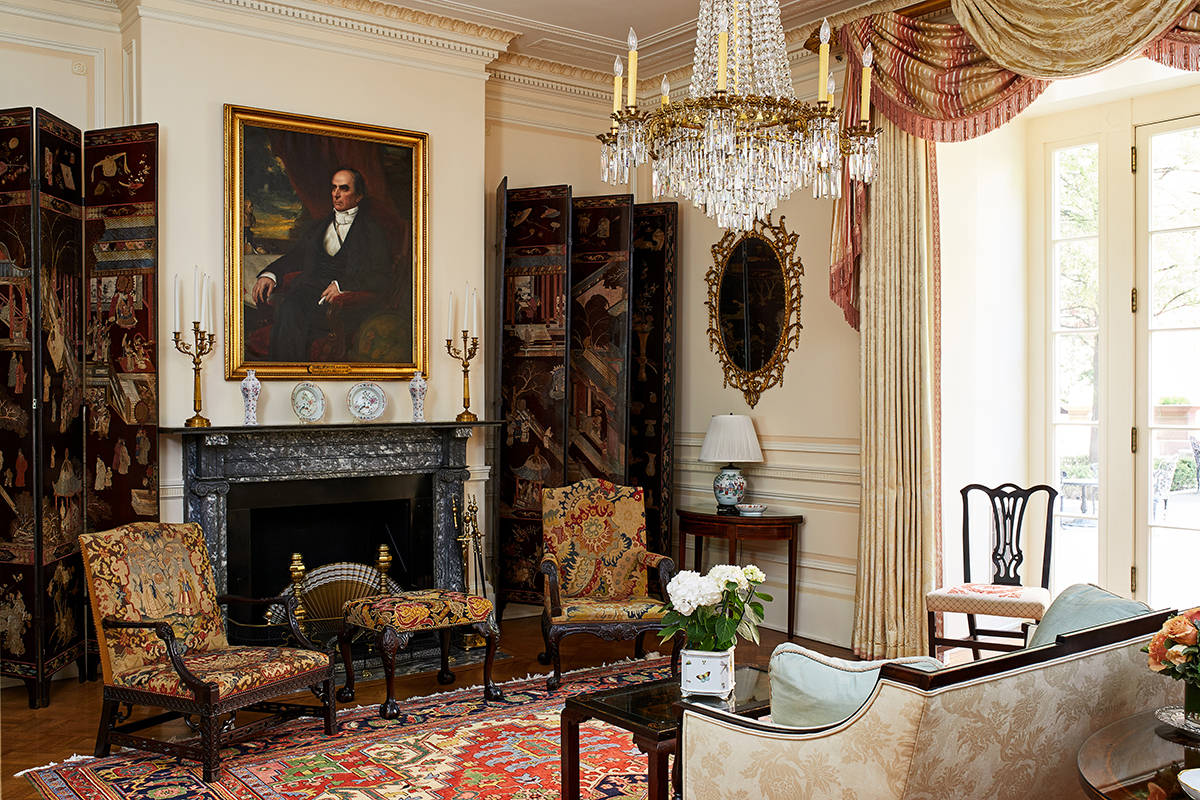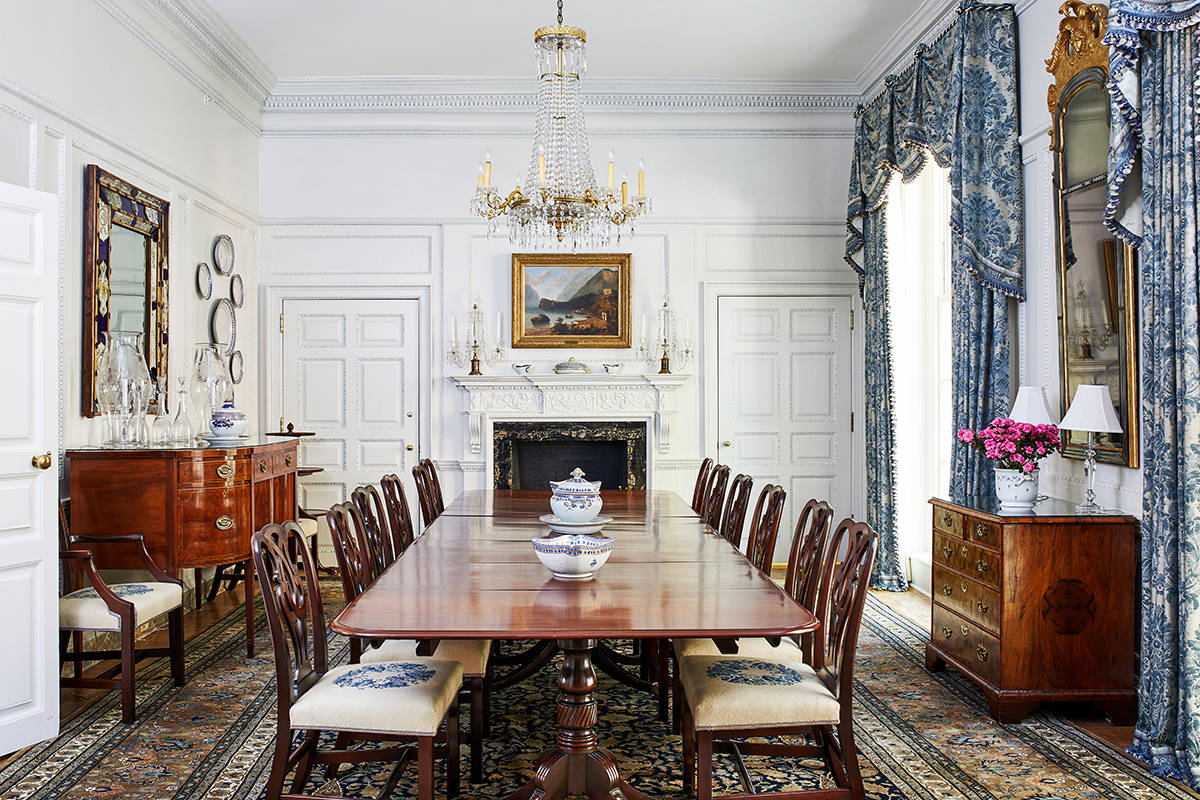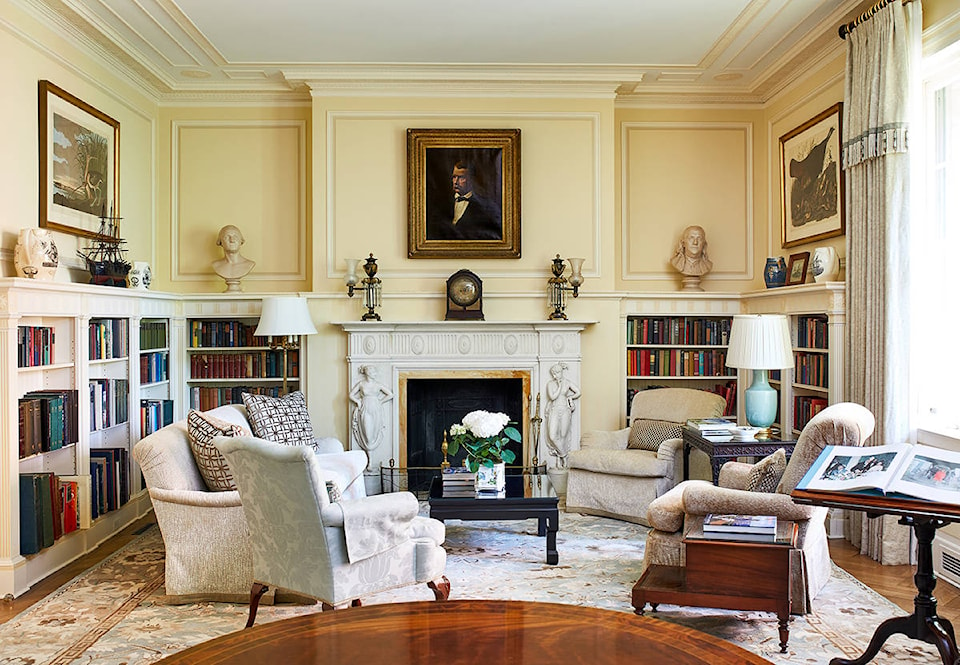WASHINGTON - Diagonally across the street from the White House is a historic home that’s even harder to wrangle an invitation to.
It’s Blair House, the president’s guesthouse since 1942, where security is tight and access exclusive. There are no official tours. The four connected 19th-century townhouses have the warm look of a large family home created over time: a more than 120-room maze of antique furniture, paintings, porcelain and silver. The place has the amenities of a five-star hotel with longtime staff who attend to guests’ needs, whether bedroom slippers or an incense bowl.
“In the world of protocol, all the details matter,” says Sean Lawler, chief of protocol of the United States, whose State Department office manages Blair House.
“Blair House is one of our great American treasures,” says Capricia Marshall, chief of protocol from 2009 to 2013, who once had to delay the start of an Obama administration state dinner by 15 minutes after a head of state’s wife had a sudden “wardrobe malfunction” quickly repaired by a Blair House staff member. “The rooms and collections on display tell our American story.”
Most of these stories, of course, are secret.
Official overnight guests include chiefs of state and heads of government, such as Charles de Gaulle, Lech Walesa and Queen Elizabeth II plus their delegations, and also presidents-elect in the days just before moving into the White House. Donald Trump and his family spent the night before his inauguration. It also serves as a residence for the family of a former president during a state funeral, and a place where they receive visitors, as Nancy Reagan did in 2004 in the Truman Study. The house hosts high-level summits, dinners and receptions of presidents, vice presidents, Cabinet secretaries and foreign-policy power players.
Foreign dignitaries consider an invitation to overnight at Blair House a high honor. Lawler is usually the first to greet these guests and the last to tell them goodbye. “As I was saying farewell to French President Macron, he gripped my hand in that tight grip and told me, ‘Please make sure you tell the president that this was one of the most special moments of my life,’ ” he says.
Last year, Blair House turned 75 and celebrated with a book,”Blair House: The President’s Guest House,” written by historian William Seale and published by the White House Historical Association.
Through the decades, Blair House has adapted to changes in diplomacy, decorating and lifestyle. And as with many old American houses, it has struggled at times with water leaks and fraying curtains.
Government funds pay for the building maintenance and the staffing but not the redecorating or restoration of furnishings. Since 1985, these have been taken care of by the Blair House Restoration Fund, a nonprofit organization that has raised more than $15 million from the private sector and secured $4 million in in-kind donations, such as 150 place settings of Tiffany silver flatware.
Six years ago, Washington designer Thomas Pheasant was brought on as the latest designer to decorate America’s most exclusive guest quarters. Pheasant, known for his polished, elegant interiors, is refreshing dining rooms and sitting rooms, reimagining bedrooms and upgrading baths.
Changes are made carefully, weaving the new in with the old. Charging stations sit near 19th-century shaving stands. The old portraits are center stage in the bedrooms. No huge wall-mounted televisions here: More modest-size TVs sit on chests and stands to keep a more historical look.
Although humidors full of cigars no longer greet guests, foreign VIPs can have a smoke - yes, indoors - and antique ashtrays are at the ready. “Smoking is permitted by our foreign guests when they are in residence,” says Candace Shireman, who has been Blair House curator for 18 years. “It’s another diplomatic courtesy. But it’s very rare these days, and people usually voluntarily go out into the garden.”
Social media now shines a light on previously unseen corners. Ivanka Trump shared a photo of herself on Instagram on the eve of her father’s inauguration in front of the hand-painted 18th-century Chinese wallpaper in the Lee Drawing Room, and she later posted an image of her family (kids in their pj’s) in front of a portrait of Daniel Webster.
—-
The staff of 16 full-time employees makes sure amenities are as luxurious as at a five-star hotel, but they are known for going above and beyond in their hospitality. Whether it’s bringing a certain king a Big Mac at 2 a.m. or procuring a case of coconuts (yes, really) for a foreign delegation, they do their best to fulfill the requests. Visits take meticulous planning. “We tried to find out what foods from their home country and culture they wanted,” says Marshall. “We weren’t just serving scrambled eggs for breakfast, burgers for lunch and steak for dinner. We could make chicken tikka if they wanted.”
Guests’ valuables are locked in a safe, which has stashed bags of cash for an emir of Kuwait and jewels for the Duchess of Windsor. Flowers are arranged on site, and there’s a gym and a hair salon for blowouts before a state dinner. The in-house laundry staff does a lot of ironing. High-ranking dogs are welcomed.
The walls display a wide swath of art, from a stately 1864 portrait of Abraham Lincoln by Edward Dalton Marchant to a recent acquisition: “Bovines on the Brazos II,” painted and donated by former president George W. Bush, a Texas landscape with a longhorn cow and calf.
According to Laura Dowling, former White House chief floral designer, “it’s a long-standing tradition for the first lady to send a seasonal bouquet of fresh flowers to the visiting dignitary and spouse at Blair House, which is usually placed in the guest room.” Two bouquets of irises, the national flower of France, were arranged by the White House flower shop and presented to President Emmanuel Macron and his wife, Brigitte, when they arrived at Joint Base Andrews in April, according to a State Department spokesman. Those bouquets were displayed at Blair House during their stay. Additionally, Melania Trump sent a bouquet with a personal note to be placed in the principal suite for Brigitte Macron.
Meanwhile, Shireman rounded up French items in the Blair House collections, including 18th-century silver wine tasters and pink plates from a Limoges fish service, for a display.
Diplomacy demands discretion, but Blair House is part of living history. Former Blair House manager Mary Edith Wilroy dished about tricky diplomatic moments in her 1982 book “Inside Blair House,” written with Lucie Prinz. She shared that Israeli Prime Minister Golda Meir once requested a last-minute pedicure; staff pulled it off by soaking her feet in a large stainless-steel mixing bowl from the kitchen. During a visit by Soviet leader Leonid Brezhnev, the staff had to overlook KGB agents sleeping on the damask sofas with their shoes on.
And in 1967, Lynda Bird Johnson and Charles Robb were married at the White House and secretly spent their wedding night across the street at Blair House to escape the media. Wilroy had fancy sandwiches, cookies and champagne set out to greet them in their bedroom. The next morning, staff found all the goodies consumed. Also discovered, on the tea table, was an empty carton of Kentucky Fried Chicken.
—-
Perhaps no home in Washington, with the exception of the White House, has the long history and prominent stature of Blair House. Built in 1824 for the first surgeon general of the U.S. Army, the house at 1651 Pennsylvania Ave. NW was one of the first constructed near the White House. In 1836, it was bought by prominent newspaper publisher Francis Preston Blair, a confidant to presidents including Andrew Jackson and Abraham Lincoln. His descendants lived there for the next 100 years, amassing collections of 18th- and 19th-century English and American furniture, china and silver. In 1858, Blair built a home next door for his daughter, Elizabeth, and her husband, Rear Adm. Samuel Phillips Lee, now called Lee House.
The adjoining houses became the original president’s guesthouse, thanks to first lady Eleanor Roosevelt, who, as the story goes, convinced her husband that they must have one. Visiting British Prime Minister Winston Churchill liked to roam the White House halls in his nightshirt smoking a cigar. After she ran into Churchill in the wee hours looking for the president, the first lady had had enough.
In 1942, Franklin Roosevelt recommended the purchase of Blair House with all its historic furnishings, to serve as the official president’s guesthouse, and Congress approved it. Shortly thereafter, Lee House was added. In the 1960s, an additional two townhouses on Jackson Place NW completed the complex.
The house served many purposes. From 1948 to 1952, President Harry S. Truman and his family stayed there during a major White House renovation. In 1950, an assassination attempt was made on the president as two Puerto Rican nationalists tried to shoot their way into Blair House. Truman is said to have viewed the battle from an upstairs window. Leslie Coffelt, a White House police officer, died defending the president, and a plaque honoring his courage is installed in front of the house.
By the 1980s, outdated heating, cooling and security systems and the problems of patching together four 19th-century houses called for an overhaul. Congress designated $9.6 million for mechanical and structural renovations and the addition of a principal suite and garden room. Blair House closed from 1982 to 1988 as then-Chief of Protocol Selwa “Lucky” Roosevelt shepherded the project. Private citizens donated $5 million to the Blair House Restoration Fund for the interiors and the creation of a formal garden. Mario Buatta and Mark Hampton, two of America’s top interior designers, were hired to reimagine the rooms.
“Everything looked shabby,” Buatta told The Washington Post Magazine in 1988. After splitting up the rooms, Hampton and Buatta incorporated three generations of Blair family furnishings with their own Anglo-American styles and thousands of yards of carpet, fabric and trim. The result has mostly withstood the test of time.
But old houses are needy, and by 2012, the place was again showing signs of wear and tear, prompting Pheasant’s hiring by the Blair House Restoration Fund. The fund is chaired by Roosevelt, who after leaving her protocol position devoted herself to the preservation of the president’s guesthouse.
Pheasant is respectful of the designers who preceded him. “Mario and Mark worked hard in the 1980s to come up with a blend that would merge the Blair family taste and their eclectic mix of furniture with more contemporary taste,” Pheasant says. “There are a lot of layers here.” He is preserving much of what they did while moving toward fabrics that are easier to maintain and adding features globe-trotting guests expect. “I’m always conscious that the house is not a museum,” Pheasant says. “It’s a living, breathing guesthouse.”
The library, where presidents-elect often practice their inauguration speeches the evening before the big day, was reimagined in a mellow yellow with ivory details and more-tailored curtains. Pheasant has updated five bathrooms in light palettes with marble, stone and sleek glass showers, improved lighting and larger vanities.
He also redid the principal suite, which is reserved for top VIPs (with foyer, two bedrooms, two baths and a sitting room). In the main bedroom, the 1980s blue-and-raspberry chintz traditional bedspread has been replaced by a white cotton pique coverlet, Egyptian cotton linens with blue “BH” monograms and bed hangings in pale blue and gold.
The former queen-size mattress in this main bedroom has been supersized. Now, the president’s houseguests, whether empresses, former first ladies or prime ministers, will be sleeping on a California king.
Jura Koncius/The Washington Post



